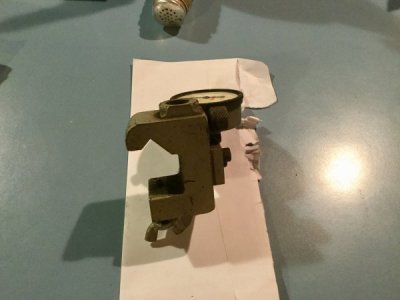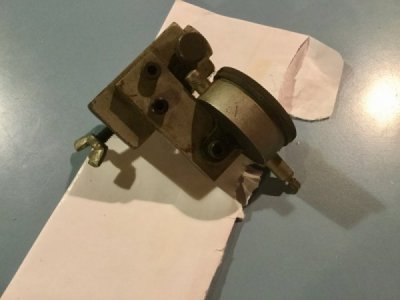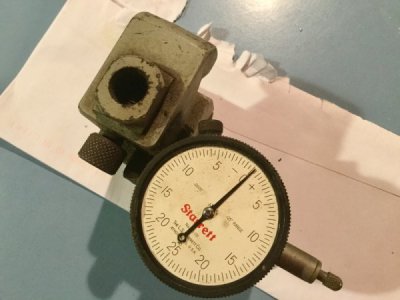-
Welcome back Guest! Did you know you can mentor other members here at H-M? If not, please check out our Relaunch of Hobby Machinist Mentoring Program!
You are using an out of date browser. It may not display this or other websites correctly.
You should upgrade or use an alternative browser.
You should upgrade or use an alternative browser.
[Read!] What Is This Used For?
- Thread starter Elmo
- Start date
- Joined
- Mar 19, 2014
- Messages
- 2,681
It clamps onto your bed/ways and monitors your carriage travel. Take the dial indicator off and replace with a rod or similar and you can use the thing as a carriage stop…Dave
- Joined
- Dec 27, 2014
- Messages
- 4,056
There is a hole with a set screw beside the dial indicator, what is it for?
Possibly for holding the indicator to check run-out on a piece in the chuck, or in case of a four jaw chuck, to assist in indicating the work.
- Joined
- Dec 6, 2012
- Messages
- 2,677
Please note that this is not a "carriage stop".
Do not power the carriage into the stop.
Get close and turn off the powerfeed. Use the hand wheel to move the cutting tool / carriage to the designated place.
Any attempt to use the carriage stop to halt the progress of the carriage may mess up your half nut and Z lead screw.
This is likely completely obvious to you and others.
Regardless, years from now someone will read this thread and trash their lathe, misunderstanding the intent of the writers.
Daryl
MN
Do not power the carriage into the stop.
Get close and turn off the powerfeed. Use the hand wheel to move the cutting tool / carriage to the designated place.
Any attempt to use the carriage stop to halt the progress of the carriage may mess up your half nut and Z lead screw.
This is likely completely obvious to you and others.
Regardless, years from now someone will read this thread and trash their lathe, misunderstanding the intent of the writers.
Daryl
MN
Last edited:
- Joined
- Dec 11, 2012
- Messages
- 71
Thanks for the reply, I do know that it wouldn't do for a stop if the carriage is under power. Somewhere I have seen a thread where a guy made a linkage that had a connection to the feed handle with a adjustable stop and it would pull the feed handle when the carriage hit the stop. I wish I had paid more attention to it!Please note that this is not a carriage stop.
Do not power the carriage into the stop.
Get close and turn off the powerfeed. Use the hand wheel to move the cutting tool / carriage to the designated place.
Any attempt to use the carriage stop to halt the progress of the carriage may mess up your half nut and Z lead screw.
This is likely completely obvious to you and others.
Regardless, years from now someone will read this thread and trash their lathe misunderstanding the intent of the writers.
Daryl
MN
Elmo
- Joined
- Dec 20, 2012
- Messages
- 9,422
Some lathes (like my Emco Super 11) have a clutch on the drive rod that slips when the saddle hits a carriage stop. This is more an anti-Rookie-operator device than for use in standard operations. As Daryl says, a carriage stop is not a hard stop.
B
British Steel
Forum Guest
Register Today
Some HARD carriage stops, like on my Holbrook model C, are INTENDED to be used regularly - there's a gauge tray on the front way cover with a 0-0.500" micrometer head at one end, a stop rod with 0.500" increments at the other (mounted to the top of the QCGB), similar on the cross-slide, and both directions of feed have their own torque-sensing trips that disengage the (separate) cross and carriage feeds - damn complicated! Separate pickup gear on the feed shaft for each feed, cam ramps on that gear (that drives the individual worm that in turn drives either the cross-feed screw or the rack pinion gear) and a sprung " follower" with a ramped groove a pin rides in. The individual worms swing around the feedshaft in and out of engagement and latch in place - until the carriage or cross-slide hits its micrometer stop, torque between feedshaft and gears/worm pushes the cam ramps apart and the ramped groove pushes the release pin and that lets the worm drop out of engagement - elegant, if complicated, but it stops *on the micrometer stop* every time, +/- a few tenths of "spring"...
Excuse the poached pictures, I haven't had to go this far on mine yet...
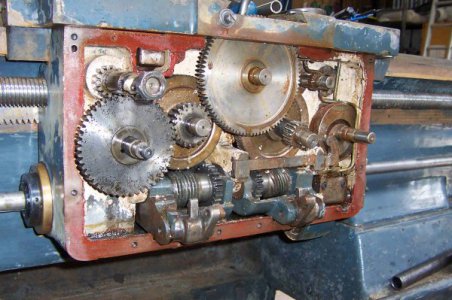
(Apron showing worms in carriers - carriage feed on left, cross feed on right. No, you don't want to drop it without a sturdy assistant!)
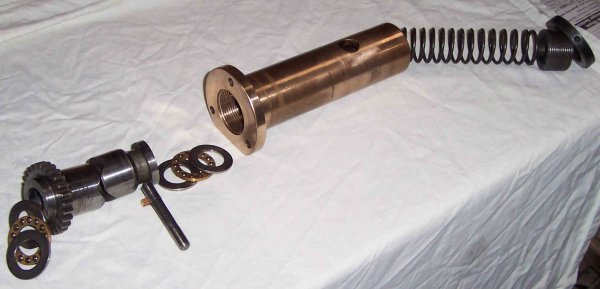
(the tailstock-side cam setup for cross-feed - hidden behind the worm in t'other pic., bronze housing is flipped 180 though!)
The amount of complication on these beasties probably explains their rarity - they were just too expensive for factory use and wound up in toolrooms, government research establishments and, eventually, in the hands of lucky sods like me, for less than the price of a new minilathe Not for the faint-hearted though, 2 tons to move around!
Not for the faint-hearted though, 2 tons to move around!
Hardinge, Hendey, Pratt & Whitney, in fact the majority of toolroom lathe makers, fitted similar features on their lathes (although some are "soft stops" and work by dogs on the feedshaft disengaging the feed drive at the gearbox end - different approach to the same job) to make life a bit easier and more accurate, I admit I like being able to make a coffee and roll a cig' while it looks after itself on long cuts...
Dave H. (the other one)
Excuse the poached pictures, I haven't had to go this far on mine yet...

(Apron showing worms in carriers - carriage feed on left, cross feed on right. No, you don't want to drop it without a sturdy assistant!)

(the tailstock-side cam setup for cross-feed - hidden behind the worm in t'other pic., bronze housing is flipped 180 though!)
The amount of complication on these beasties probably explains their rarity - they were just too expensive for factory use and wound up in toolrooms, government research establishments and, eventually, in the hands of lucky sods like me, for less than the price of a new minilathe
Hardinge, Hendey, Pratt & Whitney, in fact the majority of toolroom lathe makers, fitted similar features on their lathes (although some are "soft stops" and work by dogs on the feedshaft disengaging the feed drive at the gearbox end - different approach to the same job) to make life a bit easier and more accurate, I admit I like being able to make a coffee and roll a cig' while it looks after itself on long cuts...
Dave H. (the other one)


